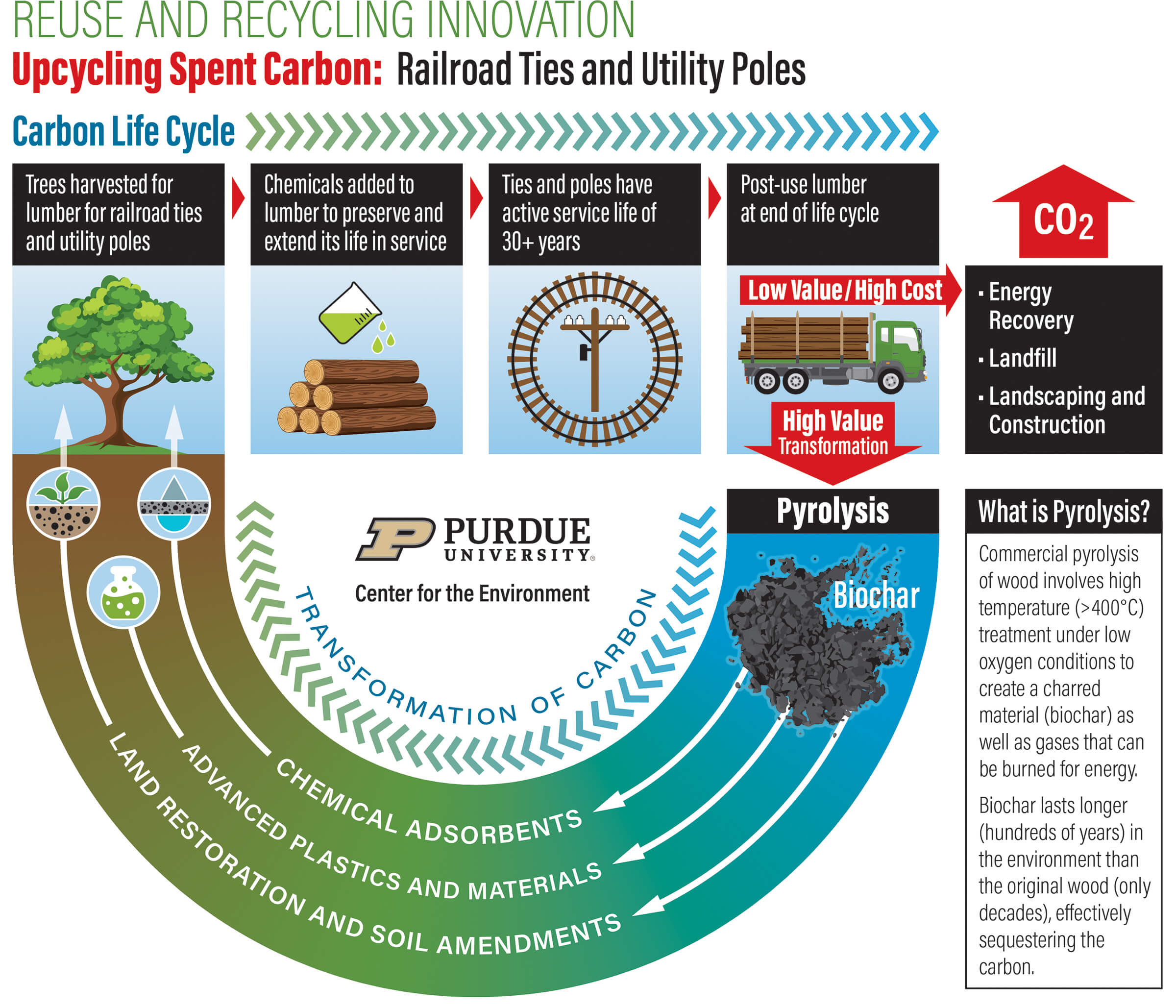January 29, 2021
Discovery Park center to research safe conversion of spent railroad ties to new high-value products
 Image provided
Download image
Image provided
Download image
The U.S. rail system retires approximately 21 million railroad ties each year, and utility companies annually remove 2 million wooden poles from circulation, resulting in upward of 6 million tons of chemically treated wood waste. Repurposing used ties and poles into new value-added materials could significantly reduce waste and bring other benefits to the environment.
Now, researchers at the Center for the Environment (C4E) in Purdue’s Discovery Park will investigate this possibility in collaboration with the newly formed Repurposing Carbon Consortium.
The consortium, which includes industry partners Indiana Rail Road Co., CSX Transportation Inc., Stella-Jones Corp. and Koppers Recovery Resources LLC, has signed a five-year agreement with Purdue. The consortium’s initial project, led by C4E affiliate Abby Engelberth, associate professor of agricultural and biological engineering and environmental and ecological engineering, will pursue research to address effectively, economically and sustainably the challenge of finding new high-value markets for custom biochar mixtures created from pyrolysis of spent ties.
Circular economic approach
Under current disposal pathways for waste railroad ties and utility poles, about 65% are used for local energy recovery, 25% are used for landscape materials, and 6% go to landfills, according to a Railroad Tie Survey Report. There are, however, diminishing disposal and reuse options available to the industry because of environmental regulations related to the chemical preservatives in the wood, less costly alternatives for on-site power generation, and rising disposal costs.
Additionally, an industrywide objective to support national efforts to reduce carbon pollution into the atmosphere has propelled a call for innovation into environmentally benign or even restorative options. The World Economic Forum has identified a circular economic approach as a way to reduce carbon footprint and increase the useful life of resources. Researchers believe that turning end-of-life ties and poles into new value-added materials could significantly reduce waste and increase railroads’ participation in the circular economy.
Thermochemical transformation
One potential solution being explored at Purdue is the conversion of spent ties and poles into biochar, a substance similar to charcoal that is created when woody biomass is burned using a low-oxygen process called pyrolysis.
Taken from the Greek words pyro ("fire") and lysis (“to unbind”), pyrolysis involves heating organic materials in a low-oxygen environment at temperatures up to 1,000 degrees Fahrenheit. Within a few hours, the material is thermochemically transformed and can then be processed into materials with potentially new higher-value applications such as water purification, polymer additives, soil amendments, and chemical feedstocks.
“In this initial project, we are bringing together expertise from Purdue and partners at the USDA Agricultural Research Service to investigate the physical and chemical properties of the produced biochar that make it ideal and safe for a number of environmental applications, including water purification,” Engelberth said.
New economic opportunities
A potentially important benefit of the pyrolysis-transformed ties is that the carbon locked into the biochar is environmentally stable and could last for hundreds of years before it decomposes to CO2, unlike the original ties, which decompose in a few decades. This is critical, researchers say, as some of the potential valuable applications like amendments to degraded soils could work to sequester carbon from the atmosphere and help reduce accumulation of atmospheric greenhouse gases.
“As our industrial partners also seek to reduce their carbon footprint, we hope to provide some viable solutions to them through the creation of long-lived, durable working carbon that opens up new economic opportunities,” said Timothy Filley, C4E director and a professor in the Department of Earth, Atmospheric and Planetary Sciences and in the Department of Agronomy. “This consortium with the railroad industry will help lay the tracks to take us to a new carbon economy. These consortium members are truly environmental solutions makers in the marketplace.”
In this initial project, Engelberth will be joined by Filley and several other C4E affiliates including Chad Jafvert, the Lyles Family Professor of Civil Engineering and a professor in Environmental and Ecological Engineering; Cliff Johnston, professor in the departments of Agronomy and Earth, Atmospheric and Planetary Sciences; and postdoctoral researcher Erika Foster in the Department of Earth, Atmospheric and Planetary Sciences. Also on the team are two USDA scientists, Javier Gonzalez from the National Soil Erosion Research Laboratory in West Lafayette, and Veera Boddu from the National Center for Agricultural Utilization Research in Peoria, Illinois.
About the Center for the Environment
The Center for the Environment promotes proactive, interdisciplinary research, learning, and engagement that addresses important environmental challenges. The center connects the faculty and students across departments and disciplines who work on environmental challenges by actively supporting the development and implementation of innovative projects and teams.
Writer: Angela Roberts, akroberts@purdue.edu
Sources: Tim Filley, filley@purdue.edu; Abby Engelberth, aengelbe@purdue.edu

